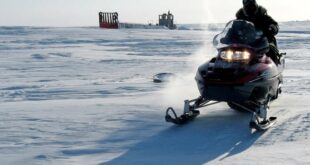Also: Home insurance in the age of climate change

Our planet is changing. So is our journalism. This weekly newsletter is part of a CBC News initiative entitled "Our Changing Planet" to show and explain the effects of climate change. Keep up with the latest news on our Climate and Environment page.
Sign up here to get this newsletter in your inbox every Thursday.
This week:
- Invasive species are costing us dearly, both in terms of dollars and biodiversity
- Home insurance in the age of climate change
- Vancouver's architecture, by design, was never meant to handle extreme heat
Invasive species are costing us dearly, both in terms of dollars and biodiversity

When it comes to the health of our planet, climate change takes centre stage, and understandably so, with its far-reaching implications. But there is another element to the health of our planet: its delicately balanced ecosystems, which are similarly threatened by human activity.
We have colonized every part of the planet, often bringing with us plants and animals from home without a thought to how that might affect their new ecosystem. And that has had a toll.
To cite one example, we saw how Guinea grass, a non-native invasive species introduced to Hawaii in the late 1800s, helped to spread a wildfire that destroyed the town of Lahaina, killing more than 100 people. While there were certainly other factors in play — such as high winds and a recent drought — it is an illustration of just how destructive an alien species can be even hundreds of years later.
A special report on invasive species issued this week by the Intergovernmental Platform for Biodiversity and Ecosystem Services (IPBES) found that invasive species introduced by humans — whether by accident or not — are having serious impacts around the world.
Some of the report's highlights:
-
Roughly 37,000 alien species have been introduced by humans globally.
-
More than 3,500 of these are harmful invasive alien species.
-
Thirty-four per cent of the impacts were reported in the Americas.
-
Two hundred new alien species are recorded each year.
-
Invasive species have played a key role in 60 per cent of plant and animal extinctions globally.
-
The annual cost was roughly $423 billion US in 2019.
It's important to note that not every alien species ends up becoming an invasive one. You wouldn't think of your tomato plants — which were originally cultivated in the mountains of the Andes — as being invasive. But when plants or animals (marine or terrestrial) have no natural predators, they can proliferate with impunity.
In Canada, there are several examples, such as the sea lamprey and zebra and quagga mussels (photo above), which were catastrophic to the ecosystems of the Great Lakes. In the case of the sea lamprey, roughly 6.8 million kilograms of lake trout were caught annually in the upper Great Lakes in the early 20th century; by the 1960s, after an explosion of the lamprey, only about 136,000 kilograms were harvested each year.
It's well known that the emerald ash borer, which is native to Asia, is devastating trees in Eastern Canada. But other species like feral pigs, rats and purple loosestrife are also wreaking havoc on ecosystems and uprooting biodiversity.
Some have been intentionally introduced, while others are hitching rides on human transportation, such as mussels, which can end up on ships that contain ballast water collected from elsewhere.
Global warming has also become a factor.
"Even without the introduction of new alien species, already established alien species will continue to expand their ranges and spread to new countries and regions," said Helen Roy, a co-chair of the assessment and a professor at the U.K. Centre for Ecology and Hydrology in Wales. "Climate change will make the situation even worse."
As the planet warms, alien species are moving to places where they may not face the same predators. And they could go from just being an alien species to an invasive alien species.
Intentional or not, invasive species are costing us dearly. For Peter Stoett, co-chair of the recent report and dean of social science and humanities at Ontario Tech University in Oshawa, it's a question of assessing the total cost.
"This report itself simply looked at crop losses, forestry income losses, things that could be really reliably measured, right? Fishing, fishing stock losses, that sort of thing," he said. "But it doesn't include some of the less reliable costs that are difficult to measure, like all the informal labour that goes into dealing with invasive species."
Then there is the human toll from invasive disease-spreading mosquitoes, such as those recently found in Africa, which have been behind the spread of malaria in some regions.
There is some good news, however: we can work on prevention. In the case of the sea lamprey, both the U.S. and Canada have a program that uses lampricides — pesticides that target larval sea lampreys — along with barriers that prevent the movement of adult sea lampreys further.
As well, Canada now has ballast water regulations that prevent ships from bringing water from elsewhere and releasing it into our lake systems. While it doesn't necessarily fix the existing problem, Stoett said it can prevent something far worse from entering our waters.
He said it's all about having the foresight to prevent more biodiversity loss and a threat to our lives and economy.
"The main stress here … is the importance of prevention," he said. "Prevention is so much cheaper than cure, right?"
— Nicole Mortillaro
Old issues of What on Earth? are here. The CBC News climate page is here.
Check out our radio show and podcast. What On Earth airs on Sundays at 11 a.m. ET, 11:30 a.m. in Newfoundland and Labrador. Subscribe on your favourite podcast app or hear it on demand at CBC Listen.
Watch the CBC video series Planet Wonder featuring our colleague Johanna Wagstaffe here.
Reader feedback
Albert Schindler:
"I must admit my ignorance, but this is the first time I heard of the environmental group On2Ottawa. Although they have my sympathy with regard to our environment— which, really, more of us should be concerned about — I cannot fully agree with their way of trying to bring about change. Their violence is just another way of expressing what they are opposing in the first place.
"I especially enjoyed reading James Westman's article about the On2Ottawa movement because he expressed a rarity in today's journalism: unbiased, informative reporting! Thank you, James!"
Peter Forte:
"Being extremely concerned about the implications of climate change and the lack of an appropriate response by the Canadian government, I was very interested by the article on the protest group On2Ottawa. I am in full agreement that some pressure must be applied to arouse public sentiment and support in order to motivate our elected leaders into action. The question is, what form should this pressure take?
"In my view, actions that disrupt everyday functions tend to alienate people rather than win their support. Similarly, defacement, temporary or permanent, of public art, smacks of nothing but pure vandalism. This certainly alienates me!"
Write us at whatonearth@cbc.ca.
Have a compelling personal story about climate change you want to share with CBC News? Pitch a First Person column here.
The Big Picture: Home insurance in the age of climate change

Across North America, it has been a summer of extremes, from wildfires in almost every corner of Canada and the U.S. West Coast to a bruising hurricane season for Florida and adjoining states. The damage has been extensive, and in what could be an omen for future disasters, the insurance industry is taking drastic measures.
Raising premiums is a predictable response in the wake of large payouts, but some of the biggest insurers are signalling it's no longer enough — they're restricting coverage or stopping it altogether. For example, State Farm, the biggest insurer in California, is no longer offering coverage anywhere in the state, which is notoriously wildfire-prone. Meanwhile, Farmers Insurance, Bankers Insurance and Lexington Insurance (a subsidiary of AIG) have pulled out of Florida, which is vulnerable not only to hurricanes but also rising sea levels. In both states, homeowners unable to find affordable rates can still buy insurance from the government, i.e. the "insurer of last resort."
Climate-related disasters are making selling insurance an increasingly risky bet. According to a report by the American Property Casualty Insurance Association and risk-analysis firm Verisk, insurers paid out about $1.03 US in claims for every $1 collected in premiums in 2022. Here in Canada, credit rating agency DBRS Morningstar has predicted this year's record-setting wildfire season could lead to insurance payouts in the range of $700 million to $1.5 billion.
Hot and bothered: Provocative ideas from around the web
-
The first African Climate Summit opened this week, with leaders across the continent asking for more financing and support to help it develop in a greener way than other continents have.
- Disposable paper cups are everywhere, offering a greener alternative to styrofoam and other plastics … right? Unfortunately, studies are showing that paper cups leach microplastics when you're drinking from them and toxic chemicals after you dispose of them.
- Decarbonizing air travel is a big challenge. Now, some startups are looking to power planes with "e-fuels" made from captured CO2.
-
Sci-fi author Jeff VanderMeer is known for bizarre novels that explore our state of "climate weirding," such as Annihilation (which was made into a movie starring Natalie Portman). In this charming essay, VanderMeer reflects on trying to make a difference to the ecosystem in his own garden.
Vancouver's architecture, by design, was never meant to handle extreme heat

Two summers ago, as Dennis Laplante baked beneath the skylights in his 1980s townhouse during a lethal heat wave, he decided the day had come to use the emergency space blankets.
He hauled two of them up a three-metre ladder to reach the windows. Using some curtain rods, he rigged the material against the skylights to block the sun from getting in.
"It was quite cheap and it worked really well," said Laplante, now 70, who has lived in Vancouver's Champlain Heights neighbourhood nearly half his life.
"The space blankets actually degraded in the sun," he noted. "The following year and this year again … we put some cardboard with aluminum foil up."
Experts say much of Vancouver's architecture is uniquely vulnerable to intensifying heat in Canada because it was designed for milder weather, leaving the city with tens of thousands of buildings needing urgent upgrades. They say designers need to shift back to basic, sustainable building techniques to keep residents cool naturally, because relying on air conditioning won't be a long-term solution.
"We have to just think really hard about the environment and not try to conquer it, but work with it," said Donald Luxton, who has worked as a heritage consultant in the city for 40 years. "And that's more, historically, how buildings were designed."
Indigenous people who lived in the area — the xʷməθkʷəy̓əm (Musqueam), Sḵwx̱wú7mesh (Squamish) and səlil̓wətaʔɬ (Tsleil-Waututh) peoples — understood the need to design buildings to work with the climate, based on their in-depth knowledge of the land.
Homes had removable curtain walls — or outer coverings — to control sun exposure and air flow. Split cedar planks were used on rooftops, which could be angled or rotated to manage rain.
"There are these innovations of Indigenous cultures … that are meaningful as we look forward now to the changing climate and how we can keep our buildings comfortable," said Nancy Mackin, an architect who studies Indigenous design.
After colonization, much of Vancouver's architecture used Victorian-era porches, verandas and small glass windows that reduced sun exposure and allowed for a cross-breeze, Luxton said. By the 1960s, mid-level high-rises were replacing single-family homes in the city's West End. Glass-walled condos started dominating the skyline in the 1980s, proving extremely profitable in a city known for its views.
"More glass was a really big, big selling point,"said Sara Stevens, an associate professor of architecture at the University of British Columbia.
The problem with so much glass, of course, is that it allows so much heat in, which must then be offset by air conditioning.
B.C. is experiencing more record-breaking summer heat waves, including the heat dome that killed more than 600 people in 2021. A review found most of those people were elderly, had a disability, lived in poorer neighbourhoods and did not have AC.
Luxton and Stevens said the city can go back to basics to undo its reliance on cooling technology. Features like heavy awnings, shaded windows, reflective exterior paint and more green space can reduce sun exposure.
In July, the City of Vancouver launched the Resilient Apartment Retrofit Accelerator program, which offers $3.5 million in funding for landlords to pay for heat-related building upgrades.
The city has taken an incentive-based approach to encouraging renovations, rather than introducing hard and fast rules, because upgrades can displace residents in a city already contending with an affordability crisis.
"We really have to be sensitive to what we do on the rental and non-market [side], because that is where people that maybe are more vulnerable [are housed]," said Sean Pander, the city's green and resilient buildings manager.
Another challenge is getting developers on board, because views still sell.
"The heat dome … has not translated yet into major changes in construction standards," said Patrick Condon, a professor of urban design at UBC.
B.C. has committed to reducing carbon emissions in the buildings sector by 59 to 64 per cent by 2030. The Pembina Institute, a non-profit energy think-tank, has estimated the residential sector will need $1.6 billion annually in retrofit incentives for the province to meet its commitment to be net zero by 2050.
After settling on his own tin-foil solution to reduce the heat inside his house, Laplante has helped an elderly friend install blackout curtains on her south-facing windows. He said he's grateful to have a fix, even if it's temporary.
"I have a solution," he said. "There's an awful lot of people who don't, and I feel for them."
— Rhianna Schmunk
Stay in touch!
Are there issues you'd like us to cover? Questions you want answered? Do you just want to share a kind word? We'd love to hear from you. Email us at whatonearth@cbc.ca.
Sign up hereto get What on Earth? in your inbox every Thursday.
Editor: Andre Mayer | Logo design: Sködt McNalty

Add some “good” to your morning and evening.
A variety of newsletters you'll love, delivered straight to you.
*****
Credit belongs to : www.cbc.ca
 MaharlikaNews | Canada Leading Online Filipino Newspaper Portal The No. 1 most engaged information website for Filipino – Canadian in Canada. MaharlikaNews.com received almost a quarter a million visitors in 2020.
MaharlikaNews | Canada Leading Online Filipino Newspaper Portal The No. 1 most engaged information website for Filipino – Canadian in Canada. MaharlikaNews.com received almost a quarter a million visitors in 2020.







